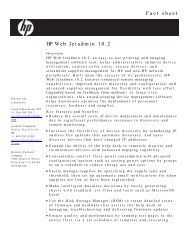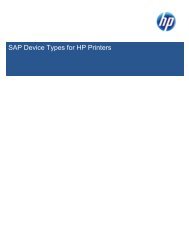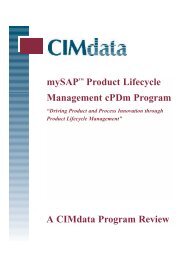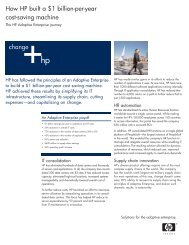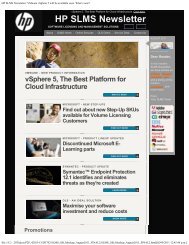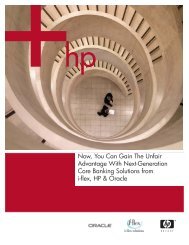Richard J. Nelson may not have been HP's first ... - Hewlett Packard
Richard J. Nelson may not have been HP's first ... - Hewlett Packard
Richard J. Nelson may not have been HP's first ... - Hewlett Packard
You also want an ePaper? Increase the reach of your titles
YUMPU automatically turns print PDFs into web optimized ePapers that Google loves.
<strong>Richard</strong> J. <strong>Nelson</strong> <strong>may</strong> <strong>not</strong> <strong>have</strong> <strong>been</strong> HP’s <strong>first</strong> calculator customer (his <strong>first</strong> HP was an HP-35A<br />
backordered in May and received on July 31, 1972), but he is certainly one of the most loyal and active in<br />
terms of machines bought, used, analyzed, and written about. Here is his list of calculators in approximate<br />
series order. <strong>Richard</strong> is <strong>not</strong> really a collector and many of HP’s customers own every one of HP’s<br />
95 models.<br />
HP-35A<br />
HP-45A<br />
HP-65A<br />
HP-55A<br />
HP-67A<br />
HP-80A<br />
HP-70A<br />
HP-21A<br />
HP-22A<br />
HP-25A<br />
HP-25C<br />
HP-27A<br />
HP-29C<br />
HP-97A<br />
HP-19C<br />
HP-75C<br />
HP-71B<br />
HP-75D<br />
HP-31E<br />
HP-33C<br />
HP-34C<br />
HP-41C<br />
HP-41CV<br />
HP-41CX<br />
HP-10C<br />
HP-11C<br />
HP-12C<br />
HP-12Cp<br />
HP12CP<br />
HP-15C<br />
HP-16C<br />
HP-18C<br />
HP-28C<br />
HP-28S<br />
HP-27S<br />
HP-22S<br />
HP-32S<br />
HP-42S<br />
HP-20S<br />
HP-21S<br />
HP-22S<br />
HP-27S<br />
HP-32SII<br />
HP-17B<br />
HP-17BII<br />
HP17bII+<br />
HP-10B<br />
HP-38G<br />
HP48S<br />
HP48SX<br />
HP48G<br />
HP48GX<br />
HP49g<br />
HP48g+<br />
HP48gII<br />
HP50g<br />
HP33s<br />
HP35s<br />
HP9g<br />
HP9s<br />
HP10s<br />
HP20b<br />
HP QuickCalc 10<br />
<strong>Richard</strong> retired nearly three years ago moving from the California LA/Orange county area to Mesa<br />
Arizona. With a 44 year career of electrical engineering, teaching electronics and technical writing<br />
<strong>Richard</strong> has always used HP calculators, especially the high end programmables, in his work.<br />
The HP65A inspired him to start a world wide HP calculator club in June 1974. He has edited, written,<br />
and published well over 5,000 pages in monthly magazines dedicated to HP calculators for 12 years. Mr.<br />
<strong>Nelson</strong> has paneled calculator sessions at several Engineering and Computer Conferences, and he started<br />
the annual <strong>Hewlett</strong>-<strong>Packard</strong> Hand Conferences with the <strong>first</strong> one in September 1979. The next HP<br />
Handheld Conference, HHC 2009, will be held October 3 rd & 4 th at HP in Fort Collins Colorado.<br />
In addition to his HP calculator writing <strong>Richard</strong> also has a hobby of designing and building HP calculator<br />
accessories. This year celebrates the 30 th anniversary of the HP-41/HP-IL calculator system which was<br />
one of HP’s most popular machines and the <strong>first</strong> model with the expandability of four ports and an<br />
alphanumeric display. HP-41 accessory examples are described.<br />
As a leading writer in the calculator user community Mr. <strong>Nelson</strong> was often asked to give technology<br />
reports to the US Navy. In one classified meeting he demonstrated how the HP-41 could be used to<br />
control just about anything. He wired a tiny magnetic reed switch across the contacts of the HP-41 “E”<br />
key. When the calculator was placed on a calculator stand input and output (external wireless) was<br />
accomplished.<br />
The HP-41 has an audible “beep” produced by a bender which was also capacitively coupled to a plate on<br />
the stand. The “E” key could be “pressed” by an electromagnet in the stand and the audio tones could<br />
provide control based on a running HP-41 program. Using a whistle switch (similar to the well known<br />
sound activated The Clapper) <strong>Richard</strong> could walk around the room controlling the room lights and a<br />
slide projector to show what was the latest in HP-41 applications. All of this was controlled by the HP-41<br />
itself. This kind of thing is trivial and routine today, but having an affordable shirt pocket calculator do<br />
this 29 years ago was “leading edge.”
Mr. <strong>Nelson</strong> was an avid promoter of program<br />
barcode as a means of program publishing.<br />
A<strong>not</strong>her example of an “accessory” he built<br />
was an HP-41 modem of sorts that utilized<br />
the HP-41 wand code to send programs over<br />
the phone lines. See the photo at the right.<br />
The transmitter label reads, “This HP-41<br />
accessory uses the HP HEDS-3000 wand to<br />
convert barcode to an audio two tone signal<br />
– 1200 & 2200 Hertz. HP-41 programs and<br />
data <strong>may</strong> be recorded on an audio recorder or<br />
transmitted by telephone using this concept.”<br />
The receiver label reads, “TONES TO BAR<br />
CODE SIGNALS, This HP-41C accessory<br />
receives two tone (1200 & 2200 HZ) audio<br />
signals from a telephone line or tape recorder<br />
and converts them into a flashing light<br />
emitting diode signal to be ‘read’ by an HP-<br />
41C wand (model 82153A). A one hour tape<br />
could store 36,000 bytes using a moderate<br />
effective scan rate of 10 bytes per second.<br />
Allowing ten seconds for voice announce-<br />
Fig. 1 – The transmitter is on the top, the receiver on the bottom.<br />
ments per program, the ten programs in the HP-41C Wand Manual would take 6 minutes, 36 seconds of<br />
tape.” The <strong>first</strong> test was sending a program from California to a<strong>not</strong>her user on the East coast. No<br />
modification of the HP-41 was required.<br />
Mr. <strong>Nelson</strong> has authored hundreds of articles on HP calculators during the last 35 years. He taught an HP<br />
48 programming class for several years and he managed the largest calculator software/documentation<br />
project ever undertaken by the HP User Community. Known as the PPC ROM project hundreds of HP<br />
users worked on writing 153 highly efficient routines that were programmed into a custom 8K ROM that<br />
was then manufactured by HP. Over 5,200 of these ROMs were made. The 500 page PPC ROM User’s<br />
Manual was written to illustrate what the users themselves thought was vital information for any software,<br />
but especially for a programmable calculator.<br />
The project took two years and at least one man century of effort. That is 876,581 hours of work by<br />
hundreds of HP users around the world. All work was volunteered and if this project was professionally<br />
done at a conservative 1980 $15 per hour, that would be $26,297 for each page of the document. In<br />
today’s dollars (’80-‘09 cpi factor 2.587379) that would be an investment of $68,040 per document page.<br />
All of this was done without email or the Internet. The PPC ROM User’s Manual is highly valued to this<br />
day as a reference because of its completeness and it (and the ROM) recently sold for $150 on eBay. It<br />
contained the listings of all ROM routines and applications programs in addition to them being provided<br />
in barcode form using a unique high density printing format. The PPC ROM project was recently cited as<br />
a prime example of organized community developed software at:<br />
http://www.embeddedcomponents.com/blogs/2007/04/community-software-development-for-embedded-devices/#comment-421#comment-421<br />
Keeping up with the latest technology and consumer electronics requires information gathering from<br />
many sources. One of these is the annual Consumer Electronics Show in Las Vegas. Mr. <strong>Nelson</strong> has
attended more than 40 consecutive CES shows and has visited and written about every HP CES booth in<br />
the process.<br />
Mr. <strong>Nelson</strong> is still very active consulting, studying, and writing about HP calculators. He has what is<br />
believed to be the largest library of HP Calculator documentation including letters, photographs,<br />
brochures, owner’s manuals, service manuals, programs, solution books, newsletters (HP external and<br />
internal), magazines, books, patents, magnetic media, operating system dumps, external reference<br />
specifications, barcode manuals, and advertisements.<br />
Many of his detailed articles on the latest HP calculators and calculator activities <strong>may</strong> be found on the<br />
Internet at the HHC websites (http://holyjoe.net/hhc/) and several other sites including HP’s website<br />
http://h20331.www2.hp.com/Hpsub/cache/392617-0-0-225-121.html.<br />
<strong>Richard</strong> enjoys corresponding with other HP enthusiasts and <strong>may</strong> be reached at rjnelsoncf@cox.net.




